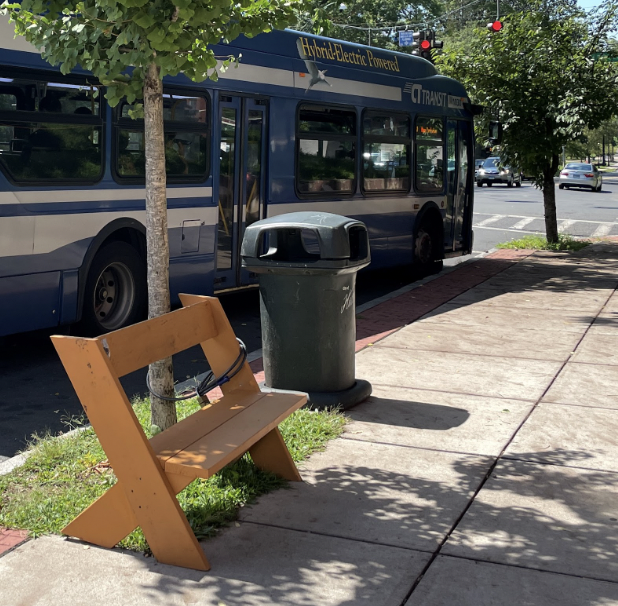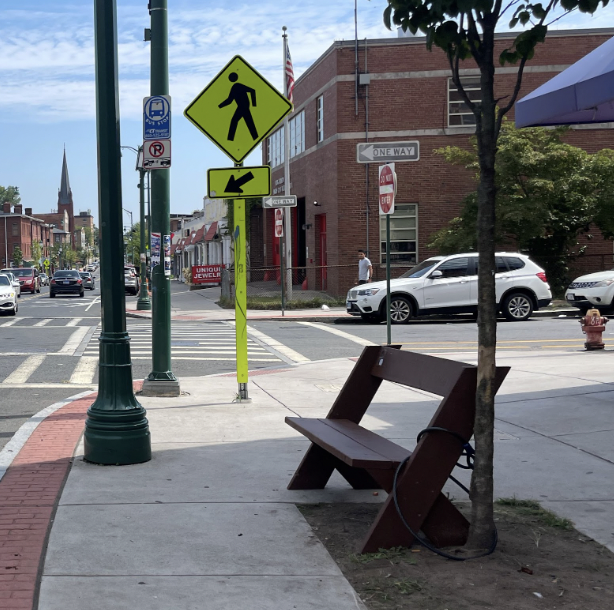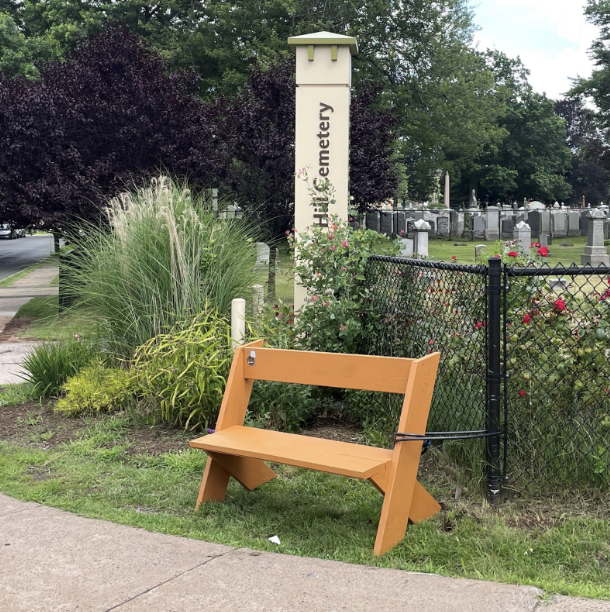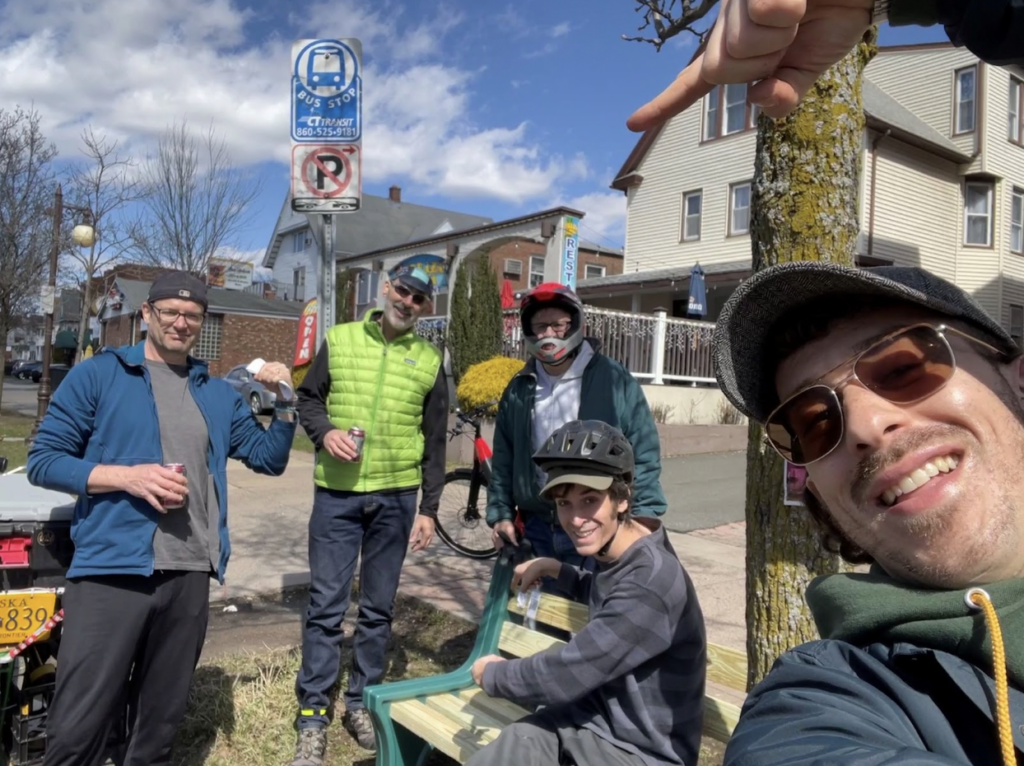Dimitris Koutoumbas
Bus stops are the front door to a public transit system, but in Connecticut, you’ll rarely find anything close to a “welcome” mat. There are about 4,300 bus stops throughout the greater Hartford area, but the majority are “sticks and poles.” More than a third of the households in Hartford do not have access to a car, and for people who rely on public transit, accessible, comfortable, and safe bus stops are vitally important. A place to comfortably sit and wait for the bus can greatly improve people’s experience with transit, encourage more people to use the bus system, and even decrease perceived wait times. That’s why, over the past year, I’ve spearheaded an effort with a local safe streets activist group to build benches for bus stops with no seating.
Connecticut Urbanists have organized more than ten builds, resulting in the placement of over thirty benches at parks, schools, and bus stops throughout greater Hartford. The bench build initiative began earlier this year with a successful crowdfunding campaign, and currently, our efforts are supported by a neighborhood beautification grant awarded to us by the City of Hartford. Seating at bus stops is essential, and with one bench at a time, we aim to instigate long-term change by fostering and developing collective ownership of the public realm through a citizen-led approach to neighborhood building.





Most of the benches built by CTUrbanists have been placed at bus stops throughout greater Hartford. Credit: Dimitris Koutoumbas.
The growing mismatch between outdated government policies and the increasing demand for people-oriented infrastructure and urban amenities has been a big driver for the rise of Tactical Urbanism, an approach to neighborhood building using short-term, low-cost, and scalable interventions. Tactical Urbanism makes use of open and iterative development processes, the efficient use of resources, and the creative potential of social interaction. As radical as it may seem, it can be initiated by a wide range of actors, including governments, businesses and nonprofits, but also citizen groups and individuals. When initiated by citizens, it is used to sidestep the conventional planning process and cut through government bureaucracy to protest, prototype, or visually demonstrate the possibility of change. When initiated by the government, well-executed Tactical Urbanism projects can be a way to bring planning proposals and pilot projects to fruition with a smaller budget and a shorter time frame.
Hartford, historically a river port city, is known as the “Insurance Capital of the World.” The capital city of Connecticut is a major hub for insurance and financial services. It is home to the nation’s oldest public art museum, the oldest public park, and the oldest continuously published daily newspaper. While significant immigrant populations and African Americans from the rural south moved to cities in the North, such as Hartford, to work in agriculture and warfare industries during World War II, federal and state-sanctioned policies and practices of the time enabled white city dwellers and their families to relocate to suburban communities. The same policies simultaneously restricted minority groups’ access to housing and financial opportunities, resulting in a situation where, today, twenty-eight percent of Hartford residents live below the poverty line. At the same time, the city struggles with persistent socioeconomic disparities, entrenched segregation, and a declining population.

The lack of adequate public transit infrastructure perpetuates the cycle of poverty by restricting residents’ ability to access employment, educational opportunities, and advanced medical care. The Capitol Region Council of Governments, the region’s metropolitan planning organization, recently completed a transit priority corridors study to identify measures to improve the speed and reliability of transit services to the six highest ridership corridors in Hartford. The infrastructure improvements recommended by the study require substantial capital investments in bus stops, transit signal priority at intersections, and the development of bus lanes to the tune of $36.4 million in 2022 dollars. Immediate action items identified in the report are limited to coordinating schedules for consistent frequencies and ongoing maintenance for existing shelters. Over a year since the study recommendations were made public, neither the city nor the state legislature has yet to commit the necessary funds for the transit priority corridors, leaving the timeline for implementation uncertain.
While planners and civic leaders often preoccupy themselves with large-scale transformative plans to bring change, CTUrbanists believe that the traditional planning and implementation process falls short of adequately addressing the immediate needs of marginalized communities. The delay in implementing the study’s recommendations was a big impetus for the group to expand its bench build effort along the six transit corridors. The report’s detailed assessment of the bus stop facilities, combined with ridership data, has allowed us to more easily identify high ridership bus stops that have no seating. The placement of each bench is ultimately decided by whether it can be adequately secured within the public Right of Way without impeding pedestrian traffic and transit operations.
To this day, twenty-seven bus stops have a bench built and placed by CTUrbanists, providing immediate relief to transit users. “I think it’s super handy,” says Matt P., a South Windsor native who regularly uses CTtransit for daily errands. I met Matt in East Hartford at one of the bus stops that has a CTUrbanists bench. The bus stop fronts a small strip mall and is next to a Dollar Tree; “It’s great for me. I usually shop at Dollar Tree, and sometimes at Family Dollar down the street. I could catch the bus at Family Dollar but I’ll come back to this stop because it’s got a bench and a timetable. You know? So that helps me a lot.” Even though the bus stop with the CTUrbanists bench sees higher ridership, the transit priority corridors study proposes that it be eliminated as part of its strategy to optimize overall stop spacing. The study recommends the existing bus stop at Family Dollar should be upgraded to include a regular-sized shelter with seating, a trash receptacle and platform level boarding. While having fewer stops can improve bus service and reduce maintenance costs, some passengers will have to travel slightly farther to and from their stops.
Providing seating at bus stops greatly improves the public transit experience for people like Matt. While decades of disinvestment have resulted in significant obstacles that impede Hartford’s efforts for equitable transportation, CT Urbanists hope their bench build initiative can be an important step towards realizing lasting change. A safe and comfortable space to wait for the bus sends a message that people who don’t use a car to get around are valued and cared for.



Dimitris Koutoumbas is a graduate student in urban planning at Hunter and currently works as a transportation engineer in greater Hartford. As an organizer with Connecticut Urbanists, he is leading the bench build initiative and advocates for a more human-centered approach to planning public spaces. He can be reached at [email protected] with any questions or comments.

